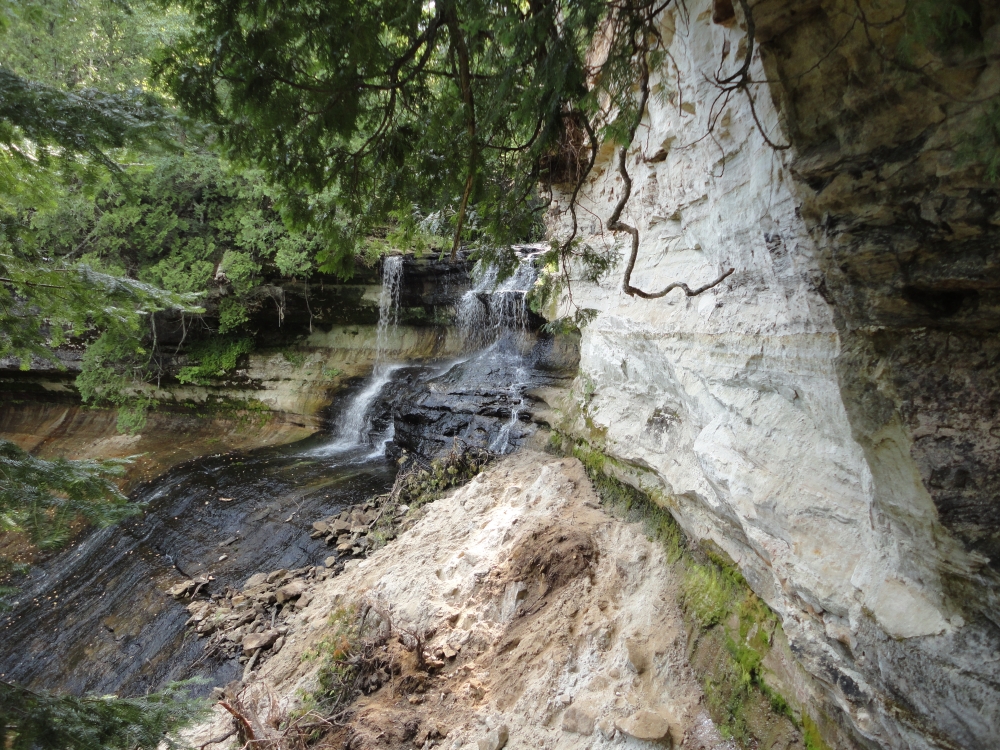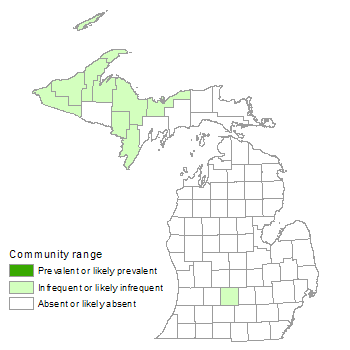Sandstone Cliff
Overview
Sandstone cliff consists of vertical or near-vertical exposures of bedrock with sparse coverage of vascular plants, lichens, mosses, and liverworts. The community occurs in the central and western Upper Peninsula, and locally in Eaton County in the southern Lower Peninsula.
Rank
Global Rank: G4G5 - Rank is uncertain, ranging from apparently secure to secure
State Rank: S2 - Imperiled

Landscape Context
Sandstone cliffs occur as part of several geologic formations, including the Copper Harbor Conglomerate, Jacobsville Sandstone, and Nonesuch and Freda Formations in the western Upper Peninsula. In the southern Lower Peninsula, sandstone cliffs of Eaton Sandstone are restricted to one area along the Grand River near Grand Ledge. Sandstone cliff is typically bordered along its inland margin by boreal forest, dry-mesic northern forest, mesic northern forest, and occasionally by forested wetlands. In Eaton County, the cliffs are bordered by dry-mesic southern forest and mesic southern forest.
Soils
There is almost no soil development on the cliffs except for shallow organic soil development along the narrow cliff summit and in crevices in the cliff face where sand particles, decaying roots, and plant debris accumulate. The breakdown of sandstone and plant matter results in an acidic, sandy, organic-rich soil.
Natural Processes
The vertical structure of cliffs causes constant erosion and restricts soil development to crevices where organic matter and soil particles can accumulate. The thin soils and direct exposure to wind, ice, and sun produce desiccating conditions that limit plant growth. However, cliff aspect and local seepages result in a variability of site moisture conditions. North- and east-facing cliffs are typically moister than south- and west-facing cliffs, because of reduced wind and reduced direct exposure to the sun. Moisture can be locally present on cliff faces due to local groundwater seepages along the cliff face and surface flow across the cliff during rain events or snow melt. Windthrown trees are common along the tops of cliffs due to strong winds and shallow soils. Windblown trees at the base of the cliff provide localized areas for soil accumulation. Sandstone cliff faces regularly break free, forming blocky talus at the base of many of the sandstone cliffs and exposing fresh, bare rock substrates.
Vegetation
While mosses, lichens, and liverworts can be common on the exposed cliff face, vascular plant cover is sparse, being generally restricted to the flat, exposed bedrock at the upper edge of the cliff (i.e., lip), crevices in the cliff face, and along the cliff base, where a slope of blocky talus typically develops. Mosses, lichens, and liverworts are dominant in groundwater seepage areas along the cliff face. Common herbaceous species associated with sandstone cliff include fragile fern (Cystopteris fragilis), northern beech fern (Phegopteris connectilis), lady fern (Athyrium filix-femina), spinulose woodfern (Dryopteris carthusiana), yarrow (Achillea millefolium), fireweed (Chamerion angustifolium), wild strawberry (Fragaria virginiana), harebell (Campanula rotundifolia), common horsetail (Equisetum arvense), grass-leaved goldenrod (Euthamia graminifolia), hairy hawkweed (Hieracium gronovii), marsh violet (Viola cucullata), and two invasive plants, pearlwort (Sagina procumbens) and Canada bluegrass (Poa compressa). Common shrubs include ninebark (Physocarpus opulifolius) and dwarf raspberry (Rubus pubescens). Trees commonly occurring at the top of the cliff include sugar maple (Acer saccharum), paper birch (Betula papyrifera), white spruce (Picea glauca), balsam poplar (Populus balsamifera), northern white-cedar (Thuja occidentalis), and hemlock (Tsuga canadensis). The one southern example of this community at Grand Ledge also supports an overstory of sugar maple, with witch-hazel (Hamamelis virginiana) and bush honeysuckle (Diervilla lonicera) as common shrubs, and common polypody (Polypodium virginianum) the most prevalent fern.
For information about plant species, visit the Michigan Flora website.
Plant Lists
Graminoids
- tufted hair grass (Deschampsia cespitosa)
Forbs
- yarrow (Achillea millefolium)
- wild columbine (Aquilegia canadensis)
- wild sarsaparilla (Aralia nudicaulis)
- harebell (Campanula rotundifolia)
- fireweed (Chamerion angustifolium)
- bluebead lily (Clintonia borealis)
- large-leaved aster (Eurybia macrophylla)
- grass-leaved goldenrod (Euthamia graminifolia)
- wild strawberry (Fragaria virginiana)
- hairy hawkweed (Hieracium gronovii)
- downy Solomon seal (Polygonatum pubescens)
- marsh violet (Viola cucullata)
Ferns
- maidenhair spleenwort (Asplenium trichomanes)
- lady fern (Athyrium filix-femina)
- slender rock-brake (Cryptogramma stelleri)
- fragile fern (Cystopteris fragilis)
- spinulose woodfern (Dryopteris carthusiana)
- northern beech fern (Phegopteris connectilis)
- common polypody (Polypodium virginianum)
- rusty woodsia (Woodsia ilvensis)
Fern Allies
- common horsetail (Equisetum arvense)
Woody Vines
- poison-ivy (Toxicodendron radicans)
Shrubs
- bush honeysuckle (Diervilla lonicera)
- witch-hazel (Hamamelis virginiana)
- Canadian fly honeysuckle (Lonicera canadensis)
- ninebark (Physocarpus opulifolius)
- choke cherry (Prunus virginiana)
- thimbleberry (Rubus parviflorus)
- dwarf raspberry (Rubus pubescens)
- wild red raspberry (Rubus strigosus)
- red elderberry (Sambucus racemosa)
Trees
- sugar maple (Acer saccharum)
- mountain maple (Acer spicatum)
- yellow birch (Betula alleghaniensis)
- paper birch (Betula papyrifera)
- white spruce (Picea glauca)
- white pine (Pinus strobus)
- balsam poplar (Populus balsamifera)
- northern white-cedar (Thuja occidentalis)
- hemlock (Tsuga canadensis)
Noteworthy Animals
Cliffs provide nesting habitat for raptors and common ravens (Corvus corax).
Rare Plants
- Carex atratiformis (sedge, state threatened)
- Cryptogramma stelleri (slender rock brake, state special concern)
- Empetrum nigrum (crowberry, state threatened)
- Gymnocarpium robertianum (northern beech fern, state threatened)
- Senecio indecorus (rayless mountain ragwort, state threatened)
- Vaccinium cespitosum (dwarf bilberry, state threatened)
Rare Animals
- Falco columbarius (merlin, state threatened)
- Falco peregrinus (peregrine falcon, state endangered)
- Haliaeetus leucocephalus (bald eagle, state threatened)
Biodiversity Management Considerations
Threats to sandstone cliffs include logging of adjacent uplands and associated soil erosion, excessive foot traffic along the upper edge of the cliff, and invasive plants. The thin soils and an unstable environment make soil development and plant reestablishment slow, highlighting the importance of minimizing logging and excessive trampling along the upper edge of cliffs. Maintaining a mature, unfragmented forested buffer around sandstone cliff may help limit the local seed source for invasive species distributed by wind or birds. Some of the invasive plants that may threaten the biodiversity of sandstone cliffs include spotted knapweed (Centaurea stoebe), ox-eye daisy (Leucanthemum vulgare), sheep sorrel (Rumex acetosella), hawkweeds (Hieracium spp.), Kentucky bluegrass (Poa pratensis), Canada bluegrass, and pearlwort. Monitoring and control efforts to detect and remove these and other invasive species will help maintain the ecological integrity of sandstone cliff and surrounding natural communities.
Variation
The sandstone bedrock varies significantly in texture and erosion resistance, which influences soil development and vegetation establishment. The single southern occurrence at Grand Ledge supports a more southern flora.
Similar Natural Communities
Granite cliff, limestone cliff, volcanic cliff, sandstone lakeshore cliff, granite lakeshore cliff, limestone lakeshore cliff, volcanic lakeshore cliff, granite bedrock glade, volcanic bedrock glade, and northern bald.
Places to Visit
- Black River Gorge, Ottawa National Forest, Gogebic Co.
- Fitzgerald Park, Eaton County Parks Department, Eaton Co.
- Laughing Whitefish Falls, Laughing Whitefish Falls State Park, Alger Co.
- Miners Falls Cliffs, Pictured Rocks National Lakeshore, Alger Co.
- Mosquito River Gorge, Pictured Rocks National Lakeshore, Alger Co.
- Presque Isle River, Porcupine Mountains Wilderness State Park, Gogebic Co.
- Tahquamenon Falls, Tahquamenon Falls State Park, Luce Co.
Relevant Literature
- Albert, D.A., P. Comer, D. Cuthrell, D. Hyde, W. MacKinnon, M. Penskar, and M. Rabe. 1997. The Great Lakes bedrock lakeshores of Michigan. Michigan Natural Features Inventory, Lansing, MI. 218 pp.
- Bornhorst, T.J., and W.I. Rose. 1994. Self-guided geological field trip to the Keweenaw Peninsula, Michigan. Proceedings of the Institute on Lake Superior Geology. Volume 40, Part 2. 185 pp.
- Dorr, J.A., Jr., and D.F. Eschman. 1970. Geology of Michigan. University of Michigan Press, Ann Arbor, MI. 470 pp.
- Faber-Langendoen, D., ed. 2001. Plant communities of the Midwest: Classification in an ecological context. Association for Biodiversity Information, Arlington, VA. 61 pp. + appendix (705 pp.).
- LaBerge, G.L. 1994. Geology of the Lake Superior region. Geoscience Press, Phoenix, AZ. 313 pp.
- Price, J.R., and M.A. Velbel. 2000. Weathering of the Eaton Sandstone (Pennsylvanian), Grand Ledge, Michigan: Geochemical mass-balance and implications for reservoir properties beneath unconformities. Journal of Sedimentary Research 70(5): 1118-1128.
- Reed, R.C., and J. Daniels. 1987. Bedrock geology of northern Michigan. State of Michigan Department of Natural Resources. Map: 1: 500,000.
Citation
Cohen, J.G., M.A. Kost, B.S. Slaughter, D.A. Albert, J.M. Lincoln, A.P. Kortenhoven, C.M. Wilton, H.D. Enander, and K.M. Korroch. 2020. Michigan Natural Community Classification [web application]. Michigan Natural Features Inventory, Michigan State University Extension, Lansing, Michigan. Available https://mnfi.anr.msu.edu/communities/classification. (Accessed: November 10, 2025).
Kost, M.A., D.A. Albert, J.G. Cohen, B.S. Slaughter, R.K. Schillo, C.R. Weber, and K.A. Chapman. 2007. Natural Communities of Michigan: Classification and Description. Michigan Natural Features Inventory, Report No. 2007-21, Lansing, MI.


